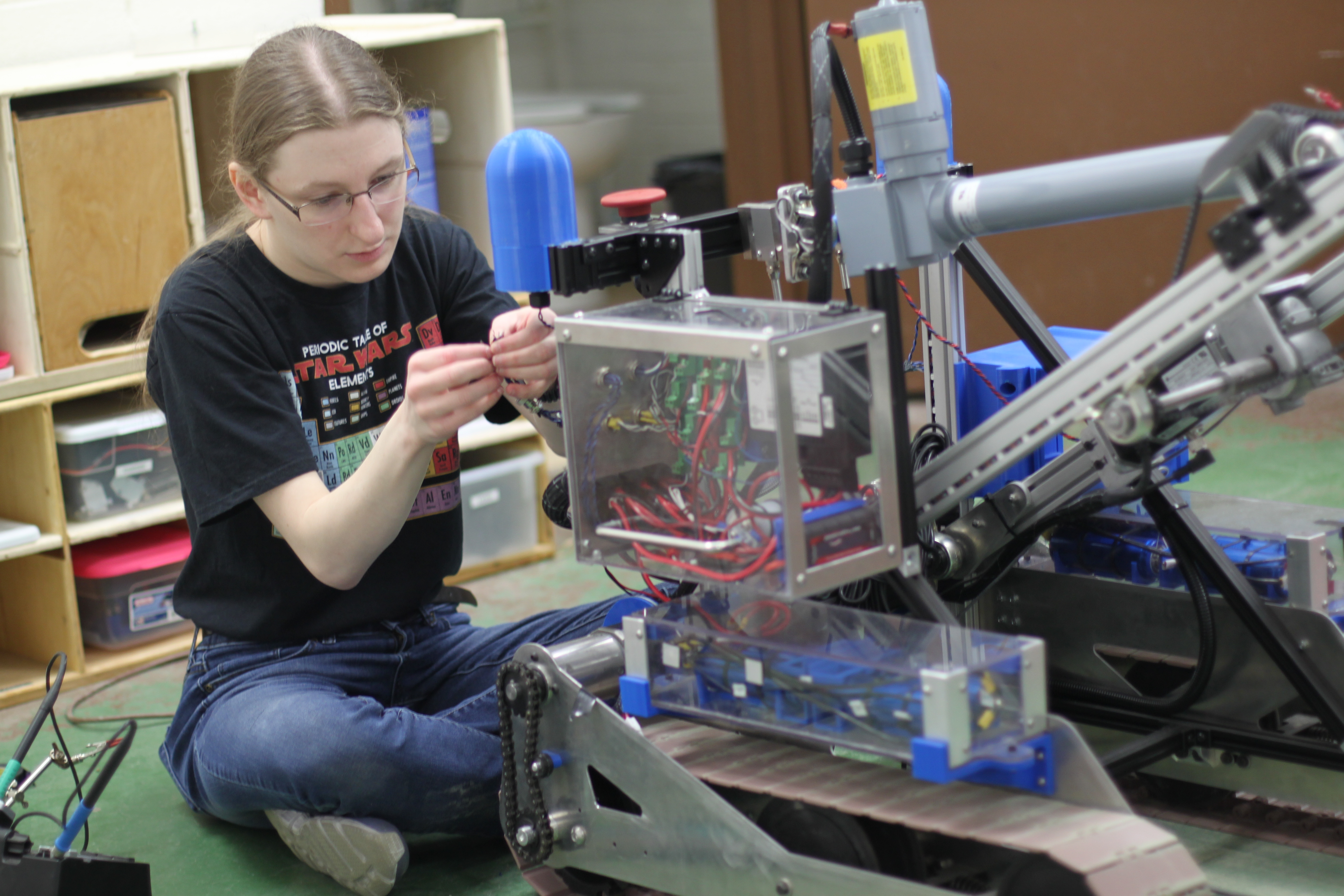The University of Akron's NASA Robotics Team is gearing up for the annual NASA Robotics Mining Competition held May 6-10 at The University of Alabama.
The 32-member team, led by outgoing president, Kelly O’Neill, has competed for 10 years and has consistently placed among the top ranking teams. In 2018, the team placed fifth overall out of 50 teams. UA, Youngstown State University, and Case Western Reserve University are the only Ohio teams participating.
Sarah Kuchcinski, third year electrical engineering major and the team's new Electrical Lead for the 2019-2020 school year, working on AUDREE.
About the competition
The competition’s tagline “Design it – build it – dig it” says it all. University students are tasked with designing and building a mining robot that can traverse a simulated Martian terrain, excavating rock/gravel and returning the excavated mass for deposit into the collector bin to simulate an off-world, mining mission. There are two, 10-minute time frames for the team to complete this task.
Teams must also submit a systems engineering paper that explains their design approach, perform K-12 outreach into their communities and give a presentation about their design philosophy at the competition. Points from all the categories determine the winner of the Joe Kosmo Award for Excellence, which comes with a $5,000 cash prize.
This year’s team goal is to develop a fully autonomous robot that does not need students to navigate or operate it.
“Achieving this is like the holy grail of robot design,” says Seth Carpenter, the team’s incoming president and software leader. “The process is tough. The different processors and robot components need to to work together harmoniously. We upgraded the sensors this year so our robot can ‘see’ better, and our systems are cohesive. I feel good about it, but I would be lying if I said I wasn’t nervous.”
Meet AUDREE
Improvements to this year’s robot (nicknamed AUDREE, which stands for Autonomous Drum Revolving Elemental Excavator) includes a drum collection instead of a backhoe, which allows a more continuous digging cycles, making it easier to dig deeper and longer to collect more gravel beneath the surface as it rotates. The locomotion system is more optimized, meaning the robot can move more easily as a result of new and improved tank treads that knocked 15 kg. off the robot’s total weight of 51 kilograms. The system runs on 24 volts (8-LiFePO4 batteries). The robot is 1.4 meters long, .75 meters wide, and .75 meters tall. Before any building begins, students model the design in SolidWorks.
All teams are required to submit a video of a working robot to NASA prior to competition.
Team makeup
The team is mostly made up of computer, electrical, and mechanical engineers. Communication is critical on a team that requires subsystems to integrate with each other to produce a full-functioning, autonomous robot.
The software team is responsible for producing over 20-30,000 lines of code to control every function of the robot – from lifting an arm to transmitting data back to the control box. The team even developed a path-finding algorithm that detects rocks and avoids obstacles.
The electrical team designs and populates their own circuit boards that contain all the processors and routing needed for the software system to run. The team comes up with new ways to reduce wiring and power consumption within the system.
The mechanical team builds all the physical aspects of the robot from power train systems for locomotion, to dust tolerant housing for electrical components. They also develop prototypes for the digging system to determine which model will be most effective at collecting material.
Preparing for a career as an engineer
Team members take what they learn in class and apply it to the design and build of their robot. Students studying mechanical engineering learn how to complete a strain and stress analysis on the materials used to create the robot so they know how much of a load it can carry. Electrical engineering students receive a deeper understanding on how resistors and capacitors work, and learn how to analyze different electrical anomalies and fix them. The computer engineers implement data structures or communication protocols that were learned in computer science or embedded systems classes. Team members learn soldering and welding – which are not typical components of engineering classes.
Since the team is responsible for developing budgets and sourcing all the parts that go into making the robot, they learn valuable budget management skills. They also regularly visit elementary and high schools and develop presentation and community outreach skills, both highly marketable skills for students preparing to enter the work force.
“When I tell hiring managers that I built a working robot that mines for rock on a simulated Martian landscape, they think I am nuts. I have definitely advanced to the next round of interviews because of my experience on the team,” says Carpenter.
With finals the same week as competition, the team has their work cut out for them over the next few weeks. Good luck, Robotics Team!

